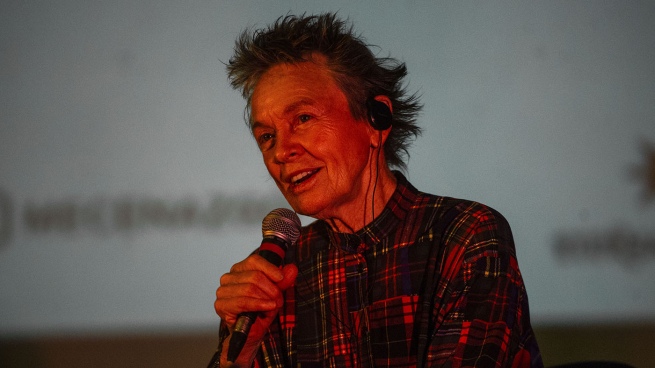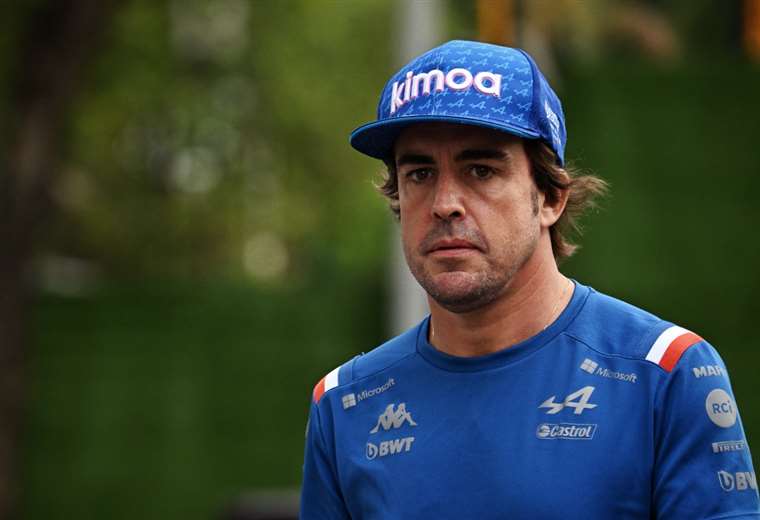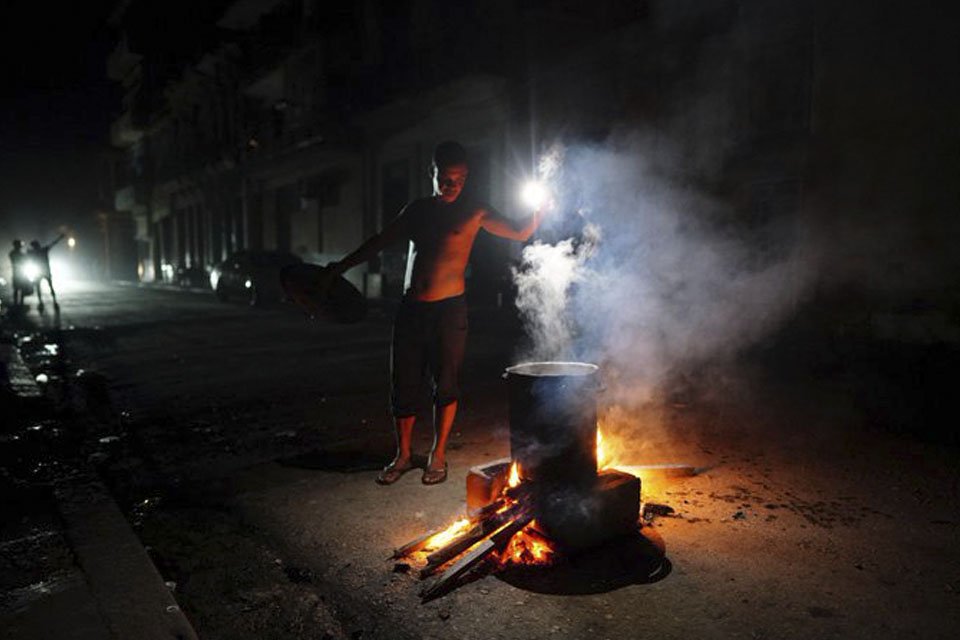The versatile artist Laurie Anderson, who was interviewed this Saturday night as part of the Buenos Aires International Literature Festival (FILBA), stressed that although she includes the story of her private life in her works
“I like to speak in the second person. I’m not interested in speaking from myself, I don’t care if you know me or not. It’s not my goal as an artist to express myself,” he explained about his artistic proposal.
He added: “If I had to define my goal as an artist it would be to try to describe something so that someone says ‘I understand what you mean’, and that sounds familiar. Recognition is what I’m looking for.”
On many occasions, the performer includes stories from her private life in her works. “I like listening to people’s stories more than her dreams,” she noted wryly.
Regarding his upbringing in the American Midwest, he said that “it is a beautiful place first of all and it has parts that are very flat, like here. The flat for me is ideal, one hundred percent horizon”.
“Many of the people who lived there lied about their origins. One of my grandparents did this: He said he came from Sweden only when he was five years old, that he started a horse business at 9, and that he got married at 11. That It was the story that we all knew for a lifetime. I didn’t find out the truth until four years ago,” Anderson recounted, and the conversation took on an intimate character.

“He didn’t come alone, he came with his parents. And his mom died right after and his dad got rid of his kids because he couldn’t take care of them. Then he looked for them again but his kids didn’t want him. My grandfather was alone. He started stealing. He was imprisoned at the age of 9 and stayed in prison until he was 19. His father put him in prison,” the artist continued, adding, “His father’s profession was to be an alcoholic. You tell the story you can tell and you don’t tell the story you can’t tell.”.
When Anderson came across this information, he looked up what prison his grandfather had been in and discovered it was Redwing in Minnesota, a US territory that borders Canada and Lake Superior.

“One of Bob Dylan’s songs is called ‘The Walls of Redwing’, it’s a very dark description. The walls were very high, the children who were locked up there were made to work. It was very difficult to get out of that prison. Listen to the song was ‘Uf'”, exhaled the artist.
And he added: “Because it had to do with the lies, with the painful stories and also when people say that music can change the world I think of Dylan, because he wasn’t talking about looking for love and being a lonely guitar player. It is not a confessional writing. He opens his eyes wide open and wonders what this world is.”.
The audience applauded. “Here we have many losers. Dylan was really excellent,” said the artist.
Anecdotes, confessions and a tribute to Dylan
The Villa Villa room of the Recoleta Cultural Center became the setting for a multifaceted interview that the actress Agustina Muñoz conducted with the famous American artist Laurie Anderson, who, within the framework of Filba, paid a small tribute to the musician and poet Bob Dylan, recalling anecdotes personal -such as that of his grandfather who was imprisoned from 9 to 19 years old- and reflected on the role of the artist.
“I don’t want to change the world, even with its collapse. I try to see things as they are and not how they should be or how they could be.”held among other definitions.
“First of all, ‘Hello,'” the creator of the musical landmark “O Superman” greeted the audience, mostly middle-aged people, although there were also young people listening carefully. “They look so comfortable sitting there,” he said in reference to a group that was sitting Indian-style very close to her and Muñoz.
Those present, who followed the dialogue with simultaneous translation through headphones offered by the organization of the event, had received with thunderous applause the visual artist, writer and performer, one of the greatest figures of the literary festival that ends tomorrow.
Anderson has a career path that constantly branches off, reaching new and surprising places each time. Muñoz, the moderator of the public interview with the artist, confessed that she spent many years without being able to define her work with a single word. However, she says that she heard the author of songs like “My Right Eye” or “Strange Angels” respond in an interview that she defined herself as “a storyteller.”
“What did I mean by this? -the American performer questioned herself-. I think that even when I’m trying to make a painting, it always has to do with some kind of story. I like to even think about a situation, even if it’s a very short story.”
For the also filmmaker, that definition refers to “a slightly lame way” of defining herself. And she confessed: “I don’t know why people insist on putting a label on it, but it seemed to me that it was a good way for the journalist to stop asking me questions in that moment”.
“Are there urgent stories to tell?” Muñoz asked. Anderson replied that he avoids the urgency. “I try to resist telling the stories that people are telling, for example, about the collapse of the planet, even though I think it’s very interesting: it’s the story of the end of the world. But it seems to me that it is a very difficult story to tell because if you do, you are telling that story to no one. So, is it perhaps a story?” the artist questioned.
“I am not so optimistic to talk about re-energizing. I don’t want to change the world, even with its collapse. I try to see things as they are and not how they should be or how they could be”Anderson pointed out.
“Within that, there is a secret that has to do with seeing things ‘improved’. Everyone has a way of imagining what that better world would be like but it’s hard to be able to strike that balance, don’t you think?” she asked wryly. The public laughed complicitly.
“What experiences or what artists produce an encounter with mystery in you?” Muñoz asked Anderson, who began to answer this question in an unexpected way: “I have a friend who gave me a pipe-shaped pen that says ‘Ceci n’est pas une pipe’ and it has a little button that says ‘No’. My friend told me: ‘You need this pen/pipe because you tend to say yes to everything’. The gift alludes to the painting “This is not a pipe”, by the Belgian artist René Magritte.
Is it possible to create music for underwater creatures? Anderson answered yes. Create a work of art with the participation of chimpanzees? Anderson again answered in the affirmative. “It’s like a drug,” the artist joked about her predisposition.
“A month ago I was visiting the Czech Republic and I was approached by a man who turned out to be the Minister of Culture of that country. He had written me a letter 30 years ago, at that time it was Czechoslovakia, so that we could go into the caves and create music,” Anderson recalled, adding, “I am a person who depends on other people’s suggestions. When someone proposes something like that to me, I get too interested. I like to get out of my own project schedule.”
Then, he listed some of his occurrences: “a sanctuary for chimpanzees in Florida. They sent me some paintings that according to these people who proposed the idea to me were created by chimpanzees. It was ridiculous. The paintings were fine. There was no need for me to intervene.”
The artist dedicated herself to working with chimpanzees that were in a shelter. One day she went with her recording equipment, her violin and with her voice, she created music that she mixed with the sounds that the animals made.
“I knocked and one of the chimpanzees, named Arthur, started to get hooked. Arthur imitated the melody again. Life can’t get any better than that,” Anderson recalled.
“I think I went off on a tangent,” said the artist at the end of the anecdote and added: “When I start doing my job, I do it with the idea that I am not a person focused on a single professional point.”
Anderson recalled that it belongs to the 60s and defined this time as a period in which there were no plans. “The situation is different now but before the people who had plans and knew where they were going to live… Those people made us feel sorry for them. I think I have that quality that belongs to the 60”, he confessed.
Asked about the relationship of her work with the world of dreams, Anderson confessed: “I like the quality of abrupt cuts in dreams, but I think that in most cases I do not always recognize the authorship in my dreams and I do not listen to them. people’s dreams.”
“Dreams are your own private theater. When you see your Uncle John it makes sense to you but not to someone else. The artist’s job is to make something that is going to make sense to others,” he noted.
The creator of “The Dream Before” expressed that she prefers “in the vigil”. “I don’t think I have a secret matter that only reveals itself in the dream. I believe that there is a way to communicate in dreams that has a silent presence. Interestingly, people aren’t talking too much,” Anderson mused, then joked, “Sometimes I also realize that I’m the director, designer, light and costume director of my dreams and I’m like, ‘Why did I make it happen? look like this?’”
“Perhaps the most interesting thing is to realize how much I project things on other people that are not related to them at all. It’s like a mirror maze,” she said.
In another part of the conversation, he pointed out that “when people say that music can change the world I think of Dylan, because he wasn’t talking about looking for love and being a lonely guitarist. It’s not a confessional writing. He opens the eyes wide open and wonders what this world is.
The audience applauded. “Here we have many losers. Dylan was really excellent”, expressed the artist.


















